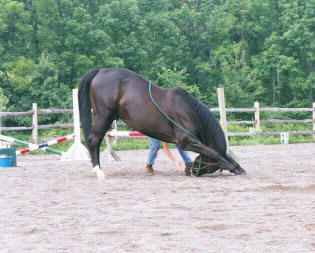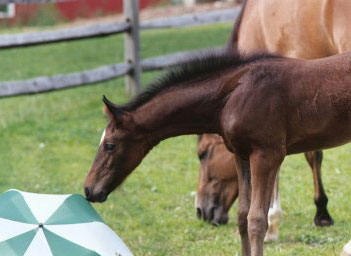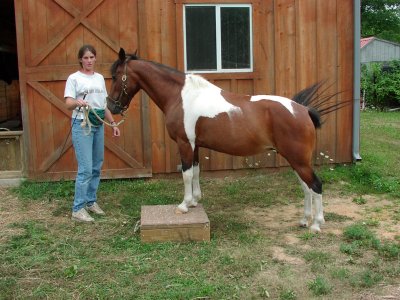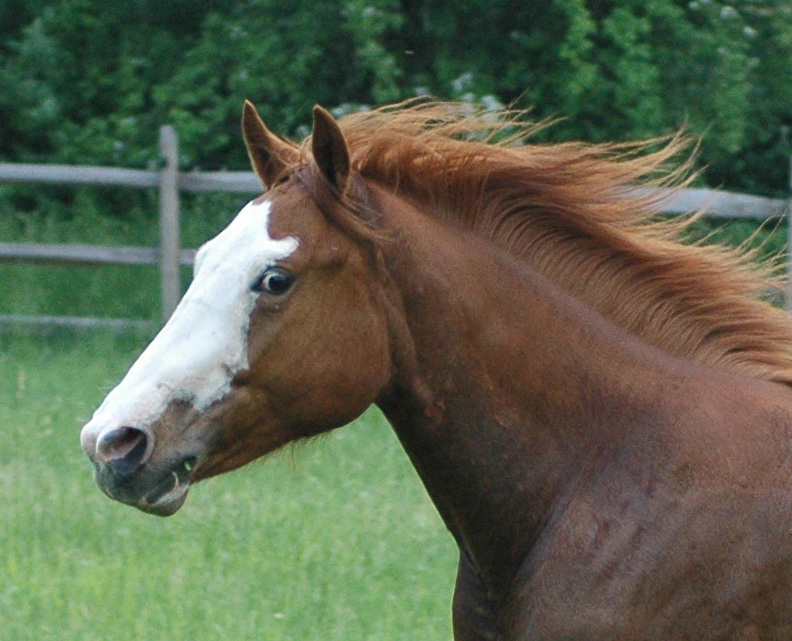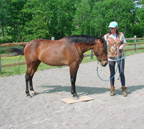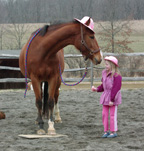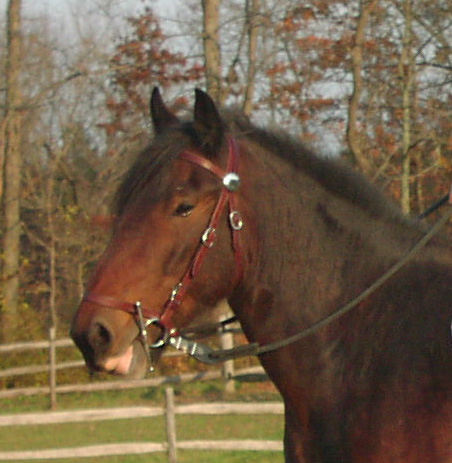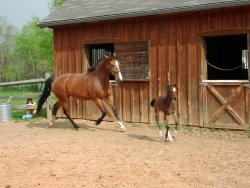Clicker Training Foals to Halter
and Lead
Barbara Ray
The following protocol is one I have used with 50+ babies and first began to use
in 1987. Since there is no "one size fits all" method, this "protocol" is
adapted as called for by a given individual baby!
One must be a good student of the foal and be willing to be guided by each foal
as a unique individual! This protocol also assumes the foal is being managed in
a way that meets its real needs for plenty of space and exercise, roughage (hay
or pasture), water, health care and social stimulation. We often will see
aberrant or undesirable behavior when a need or needs are not fully met, and
such can halt or slow training significantly. In other words, it is not the
method that is a problem, but a greater need of the living animal, who will
speak out in an attempt to get those needs mets, before s/he will be able to
absorb the benefits of becoming a thinking-learning foal, engaged in the
training game!
I try to work with foals in their pastures, paddocks or some space where they
can easily move about freely, kick up their heels a bit if they feel so
inclined, and generally work in brief, short spurts conducive to the attention
spans. Foals, quite nicely, are so curious as to have quite LONG attention spans
for babies of their comparative age, so one can, with certain babies, actually
keep them entertained for very long, 5 minute sessions, though depending on the
mood and other distractions at that time period, a foal may briefly disengage
and repeatedly reengage within seconds!
I find that working with foals in smaller confined places such as a stall
smaller than 12 x 14 has some challenges, foals seem to become easily
overstimulated, so in this type of scenario, I make sure I work in VERY brief
2-3 minute segments, or less if the foal indicates it.
I stop each session BEFORE the foal gets to practice any overstimulated
responses, and while the foal is still highly engaged in what we are doing. This
creates a sense of desire in the foal, the foal WANTS interaction with the
trainer.
Here is a good place to recall what our job is as "trainer." Training a behavior
is a process of getting an animal to do what we would like him to do willingly,
with confidence and joy, and on cue.
Our job is to convince the animal that he WANTS to do what we want him to do.
That by doing that thing, he is getting what HE wants!
The way we accomplish this with c/t is through motivating the animal with
positive reinforcement. Behavior that is reinforced tends to be repeated. We of
course, must practice our timing and rate of reinforcement abilities, so that we
reinforce highly enough and with good enough timing that we are actually marking
(with the click) the behaviors we INDEED want! We also must choose reinforcers
the animal foal actually WANTS! A weaned foal should be fully eating solid food,
and is usually willing to work for its concentrate feed or little horse cookies
or carrot pieces if it knows what these are. A foal has a very choosy palate for
many months, so we sometimes have to offer the foal plenty of exposure to
different types of treats, leaving them in the feed bin, until we can see which
of these the foal has gained a palate for before we begin training. Foals often
will work quite nicely for whither scritches and the chance to play and mouth
various textured objects such as empty plastic milk jug, towels, dog toys such
as large kongs and so forth. Always supervise foals with objects to be sure they
cannot harm themselves or swallow anything they shouldn't be swallowing.
Once we have identified reinforcers, we want to make friends with the foal. I am
not talking about just "friends," of course we all want to be our foal's friend!
I am talking, here, about a clicker-friend relationship. The foal associates us,
the trainers, with those reinforcers and learns to trust when it hears the
click, it will receive a reward, a bit of grain, a carrot piece, a neck scritch
etc.
I generally do not "charge" the clicker with foals. I like to pick a specific
criteria that is easy for me to judge and easy for the foal to accomplish, in
order to start of first-hoof with something that does not encourage or lead to
"mugging" behaviors. Most horses will, at some point, "test" the mugging to see
if it makes the vending machine work. Foals are actually PROGRAMMED to mug the
vending machine, because mare's milk letdown ONLY occurs if the foal first mugs
the teats. A weanling foal is fresh off its mum (compared to an older horse!)
and it still has this wiring to mug. (Shove its muzzle, and hard, at the
"vending machine," which is now us, to try and get it to dispense!) In captive
domestic bands, if a mare is not rebred, she will allow her foal to comfort
suckle to age 2 or 2 1/2! So it is actually not uncommon for horses to have a
drive stimulated to mug once they pair the click with us AND the reinforcement
for quite some time, even 2-3 years; and of course, even older horses long past
weaning or even that extended suckling window may try some mugging!
I find a simple way to teach a "first behavior" is to use a target and have the
foal touch that with its nose. Pretty much ALL foals want to touch novel objects
with their nose. Our job is to c/t ONLY the briefest touch, to not let the foal
bite or grab the target. At first, we may have to hold or move the target away
promptly after the first contact with the muzzle. So it is, target>foal extends
nose>touches>click>move target away and simultaneously treat. All of
this takes about a second! We're talking fast! Not so hurried we SCARE the foal,
but just a brief removing the target altogether form the picture, and offering
thr treat. Then, re-present the target and repeat this entire sequence. Maybe
5-10-15 times, whatever the foal seems to engage with! Then I will leave the
area the foal is in, let him do his own thing for 1-2 minutes, I don't talk to
him or play with him or interfere in any way with his "down time," then I return
and repeat. I might do 2-3 periods like this, maybe in 3 sessions a day for a
couple days until I can see the lightbulb on, the foal clearly understands the
click=treat and that touching the target EARNS the click/t.
I work with a number of high-fire foals who are not real keen on even being
touched by humans, as they were not imprinted or handled much the first few
months of their life. SO the great thing about the targeting, it builds up a
bank account of trust "near the human" and their trust and curiosity begin to
override their wariness of being close enough to BE touched, so that the first
touch is quite uneventful! I have had foals who are born kicking. They defend
readily with a high drive for using their hind legs, a natural response to
perceived or real threat, especially in a smaller space like a stall, but many
colts, especially will kick readily. So be safe, and be reading the body
language that the foal is getting ready to wheel and kick. Sometimes intial
touching will elicit this instinctive response. It is natural and simply OUR job
to avoid being in the way when it happens. Pretty soon, the foal figures out
that the c/t only works when s/he is FACING the human and standing on four legs!
Be respectful of the Three B's! BE Persistent, BE Consisistent, BE patient.
Really there is a 4th B, BE Knowledgeable of when to quit!
Overfacing the foal only sets back our progress. It is not undoable and we are
not necessarily "ruining" a foal, but we can create some roadblocks if we get in
a hurry. We have all heard the maxim, train as if you have ALL the time in the
world. This is true, but also, time is short, so rather than training hard or
long, train smart! Train in very brief spurts so we are, rather than rushing the
foal, leaving him wanting MORE!
Once the foal is coming to me for the target, I will begin asking him to follow
the target, doing nothing more than taking steps forward so he must take a step
to touch the target and earn his c/t. I only ask for a step or two at first.
Once the foal clearly understands the game, I will begin to "lead" him around in
a small half cirlcle, c/t, both directions, with LOTS of opportunity to touch
the target and c/t as we walk. I do not stop to give the treat if I don't have
to, as I do not want the foal to learn that c/t MEANS stop. This, for me, is
later, for purposes of riding the horse. Each trainer can choose what works best
for them, of course!
Some horses/foals do better if they stop and actually back up a step to take the
treat, so we are not inadvertently "teaching" mugging over time! My criteria is
the horse gets his treat in "his space" about 2'
from me, so this holds whether we are stopped or walking along next to each
other as he gets the treat! I prefer the horse to be always thinking "forward"
and if criteria is walking and he is still walking while he actually gets his
R+, then I am further reinforcing walking.
I DO want the foal to learn whoa, and I will stop, let the foal stop and touch
the target, and I happen to actually say "whoa" at that moment the foal's feet
stop moving, and c/t. We often talk about only adding the cue once the behavior
is learned, but if the foals feet stop, I like to pair this word all the time
with the stopping of feet.
They pick up the word whoa in like 5 minutes this way! They may not be fluent
with the cue for several days, so I always make sure I have the stop first, then
the word. Later, I will proof that by using the word, to see if the foal
actually knows what it means. If not, we train some more!
Once the foal finds it fun and enagaging, is choosing his steps to come to me
and walk with me, NOW I will begin to try touching him. I will touch him
wherever he allows it. Some foals only will let you touch the face. Some, only
the shoulders at first. Some, willturn their rump to you, to be in preparation
to bolt or kick, but once they discover the magic feeling of Butt Scritches,
they relax and learn to LIKE being touched. With some really wildish foals, it
can take several days to weeks to work one's way up their body to their heads!
Be persistent, be consistent, and be patient, is all I cna say about this! For
wildish foals, I handle them like other wild animals; I sit near them and read
books to them. 30 minutes a day, 2-3 times a day, just to habituate them to
soothing voice and unobtrusive presence of humans.
Before I leave, I will find one thing to c/t, then leave a "jackpot"
of some sort to be enjoyed at leisure. Most animals greatly appreciate this, and
it pays off in the longterm training relationship. Most trainers say they have
to have a superior performance or a breakthrough moment before they will
jackpot. I find the value of the last interaction that animal had with ME was it
got REALLY good stuff, is VERY powerful. They sleep on it or think about it
somehow, and it cna change the entire flow of training for the better in a
hurry. Besides, of what use is it to be stingy in ANY way with a growing baby
especially!
Once the foal is allowing me to touch him all over, including his head, ears
neck and poll, (all which can be c/t in baby steps as needed; I had one colt who
was so violently reactive about kicking with ANY tactile stimulation- he was
rather autistic, well, more than the usual for animals- I actually had to use a
long pole with a soft tip as my "hand" in order to not be hurt. After several
weeks though, this colt was quite safe to work around in hand!) I will be doing
a bit of massage on the poll, and the second the foal relaxes, chews or lowers
the head, even a FRACTION, c/t. I continue this to teach a head-down response.
(Horses can only lower their heads and keep them there when they are relaxed.
Head-lowering is also done when a horse is alerting and needs a different view
of the threat, but this kind of head down only lasts briefly and is followed by
the head thrown quickly back up, often with snorting or stomping or tail flagged
etc.)
A foal is going to hold his head down briefly because he has the attention span
of a flea, AND, the younger, smaller the horse, the instincts for
self-preservation cna still be so strong. There are babies of course who are
quite docile and laid back, even at a very young age! My homebred Arabian mare
was like this as a baby! I had a halter on her six hours after foaling, which I
do NOT normally do, but her mother foaled inside in a stall, and the filly was
trying to leap and run around, so I Had to get them outside where she had room!
She was so young as to not know *I* wasn't part of her Mum somehow, so the
haltering, a little foal slip, was no problem. I like to fool with newborns
briefly the first couple hours, off and on, then I like to leave them totally
alone with their mums for 24-36 hours so they can properly bond and the foal can
imprint on the mother. At day 2, I will begin a little work with the baby in
short 2-3 minutes at a time.
This, of course, also depends on the mare. It can require a second handler to
work with the mare. If the mare is upset, the baby is not learning what we want
in the presence of humans! If he learns such at his mum's side, he has not
forgotten it just because he is weaned!
Once the foal is lowering its head with brief touching or massage of its poll,
next I will introduce the ropes. I use a short, 3' section of soft cotton rope,
very pliable. I will simply c/t the same process I did to touch the foal
everywhere. I will also begin to drape the rope over the neck, over the nose,
c/t each time the foal relaxes or remains calm about it. I do not mind if the
foal wants to test the rope with his mouth. I will also then, hold the rope in a
loop, and begin to draw the loop up over the foal's face and nose "as if" I were
utting on a halter. This way, if I end up going to fast or asking for too much,
I can release the loop. Usually by this time in the training, the
loop-over-the-head is no big deal. It can be for some babies though!
I continue the "leading" exercises. Rather like off-leash heeling!
I c/t the foal for walking beside me, in straight lines, circles and figure of
eights, whoaing every now and then too, and adding neck scritches and breaks for
butt massages if the foal really likes these a lot.
I introduce the actual halter, again, letting the foal mouth it if he needs to
explore it, rubbing it on him and c/t for standing or exploring, then same as
with the rope, draping his nose, ears and poll. Putting it on is usually no big
deal now. I c/t for letting it go on, then take it off and c/t for that too.
What I really am rewarding is the ACTION of the halter over the face and ears.
It really matters not if it is going on or off. The foal should stand with his
head lowered a bit for BOTH. Some foals willraise the head HIGHER when they feel
the halter sliding over their ears as we begin to take it off. If the weanling
is already 15h tall, the head can be too high for us to comfortably reach and do
this right! I may work on
head down more, or, the foal may just need some more desensitisation
conditioning to the action over the ears. In this case, I will take a 3' section
of 1/2" garden hose and hold it in a loop. It will look a bit like the head of a
tennis racket with no strings! The hose is stiff enough to maintain the loop. I
stand next to the foal facing the same way he is, then bring the loop up and on
the head "as if" it were a halter. I can hold the loop up such that it applies
no or little pressure on the poll or even touches the ears. This way, I can c/t
various increments of criteris from no-ear-touch to full rubbing if the hose
over the ears as I pull it off. Really, this almost begs a training video,
doesn't it, to see this work in action!
Now, the foal already knows how to walk next to us and whoa, choosing his own
steps. he knows how to lower his head. He knows what the ropes feel like. He now
lets us put the halter on him. What is next is to teach him what it feels like
to follow the pressure of the rope/halter. The reason for this is, at some
point, he is going to feel that pressure, unless he is never to be tied or led
around by some less educated bloke!
It is a big shock to a horse to suddenly hit the limit of the rope, feel the tug
on his head, and not know previously what is that sensation! Ouch! So with the
foal haltered, I begin the leading around game, only every once in a while, as I
turn, say, and the foal turns, I apply some pressure on the halter with the lead
"as if" *I* was pulling his head around a bit, but not pulling, just letting the
pressure set there briefly. I c/t a relaxed response to that. I lead from both
sides (as all activity should be taught to both sides!), adding these pressures,
not so much randomly, though that too, at times, but for turns and stops, a
light backwrds pressure on the nose.
The foal already KNOWS how to whoa on his own. I am not forcing or causing the
whoa with the pressure. PLease make this distinction! As many horses ARE taught
to whoa using this R- of applied
pressure>whoa>reward by release of pressure.
Once the foal is clearly calm and easy with the pressures on his halter, I will
ask him to whoa and begin a poll-pressure testing of sorts. While he stands, I
will pull forward on the lead rope until pressure is applied to his poll. I do
NOT want to cause him to move forward, this is R- and defeats the purpose. So I
will c/t what pressure he takes and STAYS standing. But I will raise criteria
for that until I can just about lean my whole weight against the end of the rope
and still he stands there. I of course do not weigh enough to hurt the foal in
any way doing this with a standard wide web or leather head collar. But he has
to know what it feels like to have a LOT of pressure on his head and not panic
or move! Because the first time he is tied, he is likely to PUT that pressure on
himself unkowingly, and if he has no idea what that feels like or practice with
how to react, he may hurt himself or scare himself beyond repair.
When I do begin to first tie, I tie a bicycle inner tube up high, head level,
and run the lead rope through that, just holding the end, not actually tying the
foal TO anything! I move out of the way, and let the foal stand there or move
around a bit and see what he does when he gets to the "end" of the lead and the
tiretube stretches a bit. Once the foal seems bored with this, maybe 2-3 days of
a little practice for a few minutes at a stretch, I will begin to actually tie
him. The foal who never pulls is a bit of a conundrum. If he never pulls back,
he never learns how to correct the pulling back by stepping forward.
When he is an adult, and comes to pull for some reason at 5 years old, he may
end up panicking. There really isn't much we can do about this, short of
"causing" a foal to pull back so he can correct himself. I do not choose to do
this, however, I have 2 horses who
*never* pulled as foals, and then got spooked or something in some freakish
scenario as older adults, and panicked about it. I henceforth only tied those
horses with tire innertubes, as these have enough give the horse does not feel
cornered by his head. I actually don't even tie horses much at all, but many
folks do, so it behooves us to teach horses what this is and what it feels like!
My youngest horse was taught to tie with c/t, and he has never pulled, and i
doubt he will, because he has been taught that mild pressure on the halter means
"step-forward." That pressure IS a cue to eliminate the pressure. Once he let me
pull all my weight against his head with out moving, and was happy with that, I
went back to a very light pressure with the halter, and cued him to step
forward. The word cue to "walk-up" was simply paired with the poll pressure, c/t
for the step up, such that poll pressure IS a tactile cue to walk up. My
stepping forward is ALSO a cue to walk up. So the foal has 3 cues, a verbal, a
visual and a tactile. Horses easily remember ALL of these various cues and
become easily fluent with multiple cues for one response.
The word and use of pressure has a lot of negative connotation for clicker
trainers. It is too bad, really, because pressure is an inherent part of the
large, social mammal group behaviors and interactions. It is also a factor, by
default.html, of putting restraining equipment ON horses. No matter how you slice it,
a collar and leash on a dog or a head collar (halter) and leadrope on a horse is
a restraint management tool. Even when we teach Loose leash/lead walking and
free healing, it doesn't change the biomechanics OF the equipment IF and when
the animal reaches the limits of its leash or lead. The only thing is, a normal
adult horse (i.e. not mini and not
draft!) averages about 1100 lbs or so. If he decides to "go somewhere" with his
head collar and lead, we ain't gonna stop him!
Maybe we can stop a big dog, but a horse, no way. So we are pretty much
obligated to teach him to know WHAT his equipment is, what it feels like in its
"just there" mode and in its "limits" mode. I don't even need halters on my
horses to lead them around most anywhere any time. But there is a public safety
issue *IF* something strange and unusual happened to cause one of them to spook
or such. We have a responsibility to protect the horse and others from the harm
that an 1100lb animal can cause if he is running about scared and unrestrained!
To summarise, I use the c/t to teach a target, to walk beside me, to be touched,
then to walk, whoa AND be touched anywhere, then to head lower, then condition
the ropes and halter, then actual haltering, then free-leading with halter on
and lastly, feeling the various pressures of the halter and lead including tying
and self-correcting poll pressure. This last, of course, can save a horse's
life, both by PREVENTING him from panicking and self-destructing in the event of
getting spooked, caught up or hung up, and in teaching him to think about poll
pressure and be practiced in releasing unexpected poll pressure by stepping
FORWARD out of it!
I think most of these things cna also be taught in any order. I have chosen this
order because it makes sense for me. It rather backchains a bit in that by the
time I put the halter on the foal (often just a couple days after beginning this
protocol!), he ALREADY knows how to "lead" (walk beside me, turn and whoa on
cue), he knows the target, so if I need it to teach leading WITH the halter and
pressure I have that tool, and he already knows head-lowering, which allows me
to get the halter on and off and be assured the foal is relaxed about it.
In a matter of prudence, I have skipped immense details here of "life with
foals" using clicker training to teach haltering. If anyone has specific
questions or would like more detail or clarification, please ask!
Happy Training!
Barbara Ray
--
This article was originally posted on the clickryder
list in September 2005. A list member asked Barbara why she initially taught the
foals to stand while pressure was applied instead of teaching the foal to move
away from pressure right away. Here is her reply:
Yes, that (teaching foals to stand for pressure)
came out of being around several adult horses who were not able to tie ever
because they would literally lose their minds!
So I experimented with a lot of ways to teach a baby what that head confinement
is and what to do about it. I also found that most horsemen want to teach the
babies to IMMEDIATELY step forward ANY time they feel the poll pressure or pull
on the side of the halter etc.
but these babies didn't then seem to know what to do when a lot of pressure
occured, maybe a few years later when for some reason or other they got backed
up to the end of their tie and boom...
So I started with standing and being okay with the pressure, not moving forward
and not moving backward. Once the foal/horse can handle that, which is rather a
conditioning/habituation process, then asking the horse to step up, and then
having the pressure BE the cue to step up. So more or less a way of backchaining
the whole thing!
--
other list member asked if it was confusing for the
foals to learn pressure = stand and then to learn pressure = move, and how
Barbara decided how much pressure to apply. She replied:
It is a matter of baby steps, breaking down criteria
of "what is" pressure=stand.
MOST foals will automatically stop and freeze when they feel a certain amount of
pressure on the poll. It is different for each horse. So I just observe, as we
are standing in "whoa" or on a mat or whatever, I will add enough pressure I get
the ears to tell me the foal feels it, but not so much he moves. I do not want
him to even raise his head or put pressure back against it, just hold himself
there. So this pressure might last 2 seconds and be very light and c/t.
We work up to standing with a lot of pressure. No moving is no panicking and
gets c/t.
After the foal is very reliable in this, I will change the rules a bit, add a
little pressure on poll and then cue the foal to "step up"
(or "walk" whichever I am using for that foal, I usually teach both!); many
foals at first will START to move, because the "step up" is a well rehearsed
prior cue and the foal knows what to do when he hears it. But then he remembers
at the last second, he is "supposed" to stand when he feels poll pressure! So I
c/t that moment he "thinks"
about moving forward. It only takes them a short time to figure out the new
rules.
After I teach "step up" from poll pressure, I do not go back and do anything
with pressure = stand. The only point of that exercise for me, is to teach the
foal to think about poll pressure, if it happens, as being a reason to stand or,
preferably, step up out of the pressure. So he is free to choose what he does on
his own, in the future, if he is ever tied or gets hung up. He "should" step up
out of the pressure, but if he can't, he is perfectly schooled to stand with
that pressure too and not panic.
--
About Barbara Ray:
Her background is in ethology/biology and equine
science and reproduction. She is currently the Conservation Education
Director for the Ohio Wildlife Center. She was a trainer at the Columbus Zoo for
15 years where she had the great fortune to work with hundreds of species She has
been teaching riding and animal trainers since 1980, and has used clicker
training with horses and wildlife as her primary teaching tool! She currently
works with just a small handful of students and horses as time permits, plays
with her own horses, and teaches dog agility at Dogwood Training Center in
Ostrander, Ohio. She has working black and tan coonhounds and enjoys conducting
wildlife biosurveys using the detector dogs as companions, sometimes, joyfully,
from the back of a horse! She is a regular contributor to the clickryder
list sharing her experiences with exotics and with training dressage horses. Her
new web site is
www.cohorse.org.
